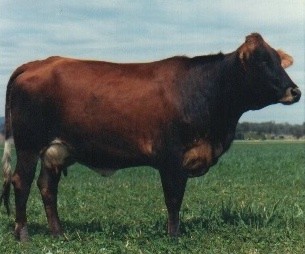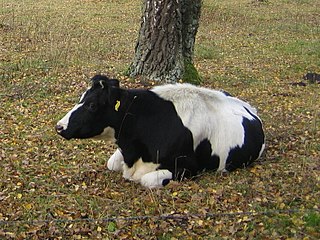Related Research Articles

The Holstein Friesian is an international breed or group of breeds of dairy cattle. It originated in Frisia, stretching from the Dutch province of North Holland to the German state of Schleswig-Holstein. It is the dominant breed in industrial dairy farming worldwide, and is found in more than 160 countries. It is known by many names, among them Holstein, Friesian and Black and White.

The Guernsey is a breed of dairy cattle from the island of Guernsey in the Channel Islands. It is fawn or red and white in colour, and is hardy and docile. Its milk is rich in flavour, high in fat and protein, and has a golden-yellow tinge due to its high β-carotene content. The Guernsey is one of three Channel Island cattle breeds; the other two are the Alderney, which is now extinct, and the Jersey.

Dairy cattle are cattle bred with the ability to produce large quantities of milk, from which dairy products are made. Dairy cattle generally are of the species Bos taurus.

The Dairy Shorthorn is a British breed of dairy cattle. It derives from the Shorthorn cattle of Teesside, in the North Riding of Yorkshire and in Northumbria in north-eastern England. The Shorthorn was for this reason at first known as the Durham or Teeswater.

The Brown Swiss or American Brown Swiss is an American breed of dairy cattle. It derives from the traditional triple-purpose Braunvieh of the Alpine region of Europe, but has diverged substantially from it. It was selectively bred for dairy qualities only, and its draft and beef capabilities were lost. Milk yield was measured in 2013 at 10231 kg (22600 lb) per year; the milk has about 4% butterfat and 3.5% protein and is suitable for making cheese.

The Red Sindhi is a dairy breed of zebuine cattle. It is believed to originate in western Sindh and in the Las Bela area of Balochistan, now in Pakistan. It is widely kept in Pakistan, where in 2006 there were approximately 3000000 head; there are small numbers in India and in Bangladesh. Other names include Las Bela, Malir and Sindhi.
The Agerolese is a breed of dairy cattle from the area of Agerola, in Campania in southern Italy. It is particularly associated with the Sorrento Peninsula and Monti Lattari. It derives from cross-breeding of indigenous Podolica cattle with Italian Holstein-Friesian, Bruna Italiana and Jersey cattle. It is one of the sixteen minor Italian cattle breeds of limited diffusion recognised and protected by the Ministero delle Politiche Agricole Alimentari e Forestali, the Italian ministry of agriculture.

The Australian Friesian Sahiwal, is an Australian breed of dairy cattle whose development commenced in the 1960s by the Queensland Government. It is a combination of the Sahiwal, a dairy breed of Bos indicus from Pakistan and Holstein breeds, designed for the tropical regions of Australia. Cows produce approximately 3,000 litres of milk per lactation under tropical pasture conditions with a high resistance to heat, humidity, ticks and other parasites.
The Chinese Black and White or Chinese Black Pied is a Chinese breed of dairy cattle. It derives from cross-breeding with local cows of black-and-white dairy cattle of various breeds imported since the 1870s from Canada, Germany, Japan, the Netherlands, the United Kingdom and the United States. It is the most numerous dairy breed in China and is distributed throughout the country.
Jamaica Hope is a dairy breed of cattle originating from Hope Farm in Jamaica.
Charles Roy Henderson was an American statistician and a pioneer in animal breeding — the application of quantitative methods for the genetic evaluation of domestic livestock. This is critically important because it allows farmers and geneticists to predict whether a crop or animal will have a desired trait, and to what extent the trait will be expressed. He developed mixed model equations to obtain best linear unbiased predictions of breeding values and, in general, any random effect. He invented three methods for the estimation of variance components in unbalanced settings of mixed models, and invented a method for constructing the inverse of Wright's numerator relationship matrix based on a simple list of pedigree information. He, with his Ph.D. student Shayle R. Searle, greatly extended the use of matrix notation in statistics. His methods are widely used by the domestic livestock industry throughout the world and are a cornerstone of linear model theory.

The Norwegian Red or Norsk Rødt Fe is a Norwegian breed of dairy cattle. It was formed in 1961 through successive mergers of various traditional and regional breeds. In 2016 it accounted for approximately 85% of the cattle in the country, and about 99% of the national dairy herd.

Cattle are large, domesticated, bovid ungulates widely kept as livestock. They are prominent modern members of the subfamily Bovinae and the most widespread species of the genus Bos. Mature female cattle are called cows and mature male cattle are bulls. Young female cattle are called heifers, young male cattle are oxen or bullocks, and castrated male cattle are known as steers.
The Siboney de Cuba is a Cuban breed of dairy cattle. It was developed from the 1960s through cross-breeding of Holstein Friesian and zebu stock, with a final genetic contribution of 5/8 from the former and 3/8 from the latter. It is one of several Cuban dairy hybrids of European (taurine) and zebuine cattle; others are the Mambi de Cuba and the Caribe, which are grouped with the Siboney under the name Cebú Lechero.

The Swedish Friesian, Swedish: 'Svensk Låglandsboskap', often abbreviated to SLB, is a Swedish breed of dairy cattle. It was established in about 1870 from imports of cattle of Dutch Friesian or German Black Pied type. From about 1970 it has been systematically cross-bred with the American Holstein-Friesian breed, to the point that the original Swedish type may be extinct. The name Swedish Holstein may also be used.It is a type of Swedish cattle breed.

Polled Holsteins are cattle born without horns but only occur in a small portion of Holstein cattle. The Holstein breed can go through selective breeding to produce polled calves. Polled is a natural trait for Holsteins but have not been bred for specifically. That is why a very small percentage of Holsteins are naturally polled. Bulls and cows can both carry the polled trait and pass it on to the progeny. Previous testing for polledness were not completely accurate because it was not looking for the gene directly until later discovered. Polled, also known as ‘hornless’ can result in the growth of scurs which are small loose horn growths that do not develop.
Lawrence (Larry) Raymond Schaeffer is an American geneticist, and emeritus professor of animal breeding and genetics at the University of Guelph, Guelph, Ontario, Canada.

The Dutch Belted or Dutch Belt is an American breed of dairy cattle. It derives from the Lakenvelder of Germany and the Netherlands, of which examples were imported to the United States from 1838. It became an important dairy breed in the early twentieth century, but could not compete with the Holstein-Friesian. By 1970 it was close to extinction; from 1993 the American Livestock Breeds Conservancy was active in the recovery of the breed. In 2021 it was listed as "critical" on the watchlist of the conservancy.

Dr. Christine F. Baes is chair of the Department of Animal Biosciences at the University of Guelph in Ontario, Canada. She began her five-year term in the role in May 2023. She is also a professor and Canada Research Chair in Livestock Genomics at Ontario Agricultural College at the University of Guelph.
Rebecca Edith Hickson is a New Zealand academic scientist, and is a full professor at Massey University, specialising in improving the production of beef from cast-off dairy calves.
References
- ↑ "Jennie Pryce". scholars.latrobe.edu.au. Retrieved 17 April 2020.
- ↑ "Senior Newsletter". Shrewsbury High School. Retrieved 16 April 2020.
- ↑ Pryce, J. E., R. F. Veerkamp, R. Thompson, W. G. Hill, and G. Simm. "Genetic aspects of common health disorders and measures of fertility in Holstein Friesian dairy cattle." Animal Science 65, no. 03 (1997): 353-360.
- ↑ "Five ET heifers". Dairy Australia. Retrieved 15 August 2014.
- ↑ Pryce, J. E., M. D. Royal, P. C. Garnsworthy, and Ivan L. Mao. "Fertility in the high-producing dairy cow." Livestock Production Science 86, no. 1 (2004): 125-135.
- ↑ Pryce, J. E.; Nguyen, T. T. T.; Axford, M.; Nieuwhof, G.; Shaffer, M. (1 April 2018). "Symposium review: Building a better cow—The Australian experience and future perspectives1". Journal of Dairy Science. 101 (4): 3702–3713. doi: 10.3168/jds.2017-13377 . ISSN 0022-0302. PMID 29454697.
- 1 2 3 4 "DairyBio » About Us". dairybio.com.au. Retrieved 17 April 2020.
- ↑ "Breed Development and Conformation Committee". The Holstein Friesian Association of Australia. Retrieved 15 August 2014.
- ↑ "Awards Program of the American Dairy Science Association®". Journal of Dairy Science. 99 (12): 10205–10223. 1 December 2016. doi: 10.1016/S0022-0302(16)30765-2 . ISSN 0022-0302.
- ↑ "Dairy genetics leader rated Australia's best". Farm Online. 23 October 2019. Retrieved 16 April 2020.